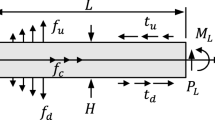Abstract
The edge function method, which involves the use of analytic solutions to model field behavior in the various parts of an elastic region, is applied to the analysis of a finite anisotropic plate with a single crack. Analytical solutions for the stress singularities at each crack tip facilitate the inexpensive calculation of accurate values of the stress intensity factors. A boundary Galerkin variational principle is used to match the boundary conditions. The method is applicable to isotropic and anisotropic materials and is demonstrated for a number of fracture problems involving variation of the crack position, crack orientation and material orientation. For the range of geometries examined in this paper, the calculated values of the stress intensity factors do not show a major dependence on the material anisotropy. The formulation of the method makes it easily applicable to the study of the interaction of several cracks and also to a limited study of crack propagation or damage development in a composite laminate.
Similar content being viewed by others
References
J.F. Dwyer, Ph.D. thesis, University College Cork, Ireland (1986).
T.H.H. Pian, P. Tong and C.K. Luk, 3rd Air Force Conference on Matrix Methods in Structural Mechanics (1971).
J.F. Mandell, F.J. McGarry, S.S. Wang and J. Im, Journal of Composite Materials 8 (1974) 106–117.
R.D. Foschi and D. Barrett, International Journal for Numerical Methods in Engineering 10 (1976) 1281–1287.
P. Tong, International Journal for Numerical Methods in Engineering 11 (1977) 377–403.
M.L. Soni and M. Stern, International Journal of Fracture, 3 (1976) 331–344.
S.N. Atluri, A.S. Koyabashi and M. Nakagaki, ASTM STP 593 (1975) 86–98.
M.D. Snyder and T.A. Cruse, AFML-TR-73-209 (1973).
G. Karami and R.T. Fenner, International Journal of Fracture 30 (1986) 13–29.
G.E. Blandford, A.R. Ingraffea and J.A. Ligget, International Journal for Numerical Methods in Engineering 17 (1981) 387–404.
T.A. Cruse and R.B. Wilson, Nuclear Engineering and Design 46 (1978) 223–234.
D.L. Bowie and C.E. Freese, International Journal of Fracture 8 (1972) 49–58.
D.L. Bowie and D.M. Neal, International Journal of Fracture 6 (1970) 199–206.
K.R. Gandhi, Journal of Strain Analysis 7 (1972) 157–163.
Y.J. Yum and C.S. Hong, International Journal of Fracture, 47 (1991) 53–67.
G.S. Gyekenyesi and A. Mendelson, Nasa TN D-7119 (1972).
P.K. Satapathy and H. Parhi, International Journal of Engineering Science 16 (1978) 147–154.
K.-L. Chen and S.N. Atluri, Engineering Fracture Mechanics 36 (1990) 327–340.
C.W. Woo and Y.H. Wang, International Journal of Fracture 62 (1993) 203–218.
H.C. Chen and J.N. Kudva, International Journal of Fracture 63 (1993) 215–228.
S.G. Lekhnitskii, Theory of Elasticity of an Anisotropic Elastic Body, Holden-Day Inc. (1963).
J.J. Grannell and P.M. Quinlan, Proceedings of the Royal Irish Academy 80A, 1 (1980) 1–22.
J.F. Dwyer and B. Amadei, Rock Mechanics and Rock Engineering (accepted for publication).
J.F. Dwyer and B. Amadei, International Journal of Rock Mechanics and Mining Sciences and Geomechanics Abstracts 32, 2 (1995) 121–133.
Author information
Authors and Affiliations
Rights and permissions
About this article
Cite this article
Dwyer, J.F., Pan, E. Edge function analysis of stress intensity factors in cracked anisotropic plates. Int J Fract 72, 327–342 (1995). https://doi.org/10.1007/BF00040371
Received:
Accepted:
Issue Date:
DOI: https://doi.org/10.1007/BF00040371




